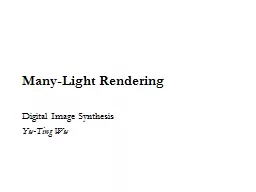

Digital Image Synthesis YuTing Wu Surface integrators Remember the radiance can be estimated by solving the rendering equation Surface integrators are responsible for approximating the integral ID: 312157
Download Presentation The PPT/PDF document "Many-Light Rendering" is the property of its rightful owner. Permission is granted to download and print the materials on this web site for personal, non-commercial use only, and to display it on your personal computer provided you do not modify the materials and that you retain all copyright notices contained in the materials. By downloading content from our website, you accept the terms of this agreement.
Slide1
Many-Light Rendering
Digital Image Synthesis
Yu-Ting WuSlide2
Surface integrators
Remember the radiance can be estimated by solving the rendering equation:
Surface integrators are responsible for approximating
the integral
L
oSlide3
Direct lighting
The simplest surface integrator: direct lighting
e
nvironment map
spot light
point lightSlide4
Direct lighting
For high-quality rendering,
simulating
direct
lighting only is not enoughSlide5
Global illumination
Simulate light paths with multi-bounce
The number of rays increase exponentially
spot light
point light
e
nvironment mapSlide6
Path tracing
The most common surface integrator for global illumination
Recursively trace radiance rays
spot light
point light
e
nvironment mapSlide7
Comparison
8 samples per pixel
Path tracingSlide8
Comparison
Path tracing
1024 samples per pixelSlide9
Comparison
Path tracing produces beautiful images, but it converges slowly
In the following, we will
introduce the many-light rendering, a more efficient method for visually-pleasing global illumination
Direct lighting
(several seconds)
Path tracing (1024
spp)(several hours)Slide10
Rendering with virtual point lights
First introduced in “Instant
Radiosity
” [Keller ‘1997]Two-pass approach
virtual point light (VPL)
shading point w.r.t. pixel sample
Pass I:Trace virtual point lights (VPLs) from light sources (attached in scene
for indirect illumination)Pass II:For each surface seen through pixels, gather lighting contributions from all virtual point lights
Pass 1
Pass 2
Pass 2Slide11
Many-Light Rendering
Later, VPL is also used to represent complex illumination, such as large area lights or environment
lighting
Sample lights uniformly on env.map and area lights
Environment lighting
[
Hasan et al. 2007]Texture lights and
indirect illumination[Walter et al. 2005]Slide12
Rendering with virtual point lights
Convert the illumination in scene into a large set of virtual point lights (Pass I)
Environment lights, area lights, and indirect illumination
100000 VPLsSlide13
Rendering with virtual point lights
For each pixel, gather all VPL’s contributions (Pass II)
100000 VPLsSlide14
Virtual point lights
Advantages
of VPL-based (many-light)
methods:All types of illumination can be gathered with an unified approachIndirect illuminationLarge (textured) area lightsEnvironment lights Low-noise property
Easier control of quality and performance
Real-time applicationsOff-line applicationsFewer VPLs
Rough (or none) visibility
More VPLsRay-traced visibilityperformance-quality tradeoffSlide15
Survey paper for Many-Light
rendering
Scalable Realistic Rendering with Many-Light Methods
C. Dashsbacher, J. Krivanek, M. Hasan, A.
Arbree, B. Walter, J. NovakEurographics State of the Art Reports 2013
Many-Light papers are classified into several categories according to their goals, performance, and capabilitiesSlide16
Challenges in Many-Light Rendering
Complex scenes usually require a large number of VPLs for detailed illumination
For example, 100K –
500KIt will be impractical to directly summing contributions from all lights
Museum scene from “
LightSlice”1024 x 1024 x 9 shading points1.5 M triangles153 K VPLsbrute-force gathering = hundreds of hours !Slide17
What’s for today
Brief introduction to three SIGGRAPH papers for
scalable many-light
renderingLightcuts
: a Scalable Approach to Complex IlluminationB. Walter, S. Fernandez, A. Arbree, K. Bala, M. Donikan, D. P. Greenberg
SIGGRAPH 2005Matrix Row-Column Sampling for the Many-Light ProblemM. Hasan, F. Pellacini, K. BalaSIGGRAPH 2007
LightSlice: Matrix Slice Sampling for the Many-Light ProblemJ. Ou and F. PellaciniSIGGRAPH Asia 2011